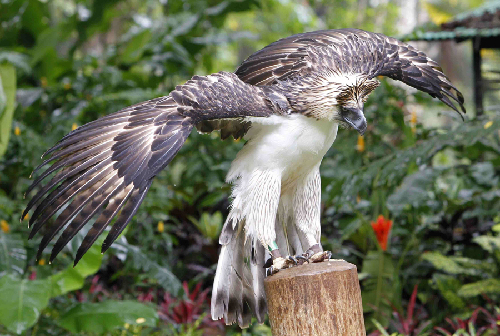The Philippine eagle or monkey eagle ( Pithecophaga jefferyi ) is a very large and powerful species from the family of the Accipitridae. The genus Pithecophaga is monotypic with the Philippine eagle is the only eagle Art The Philippines is an endemic to the Philippines and lived their primary forests, secondary forests and gallery forests.
The main foods of the Philippines eagle are arboreal mammals, besides, other mammals and larger birds and reptiles eaten. Due to continuous and rapid habitat destruction and hunting, according to the Philippine Eagle is IUCN threatened with extinction ( critically endangered ). The total population is estimated at-large uncertainties still about 90-250 pairs, maximum, he could comprise 340 pairs.
The main foods of the Philippines eagle are arboreal mammals, besides, other mammals and larger birds and reptiles eaten. Due to continuous and rapid habitat destruction and hunting, according to the Philippine Eagle is IUCN threatened with extinction ( critically endangered ). The total population is estimated at-large uncertainties still about 90-250 pairs, maximum, he could comprise 340 pairs.
Philippine eagles are powerful raptors with a strikingly high, but very narrow beak, an erectile, long and loose shaggy bonnet and relatively short but very broad wings. The tail is quite long and at the end almost straight; the legs are relatively short, but just as the toes extremely strong. The Tarsometatarsi is largely featherless. The species is similar in habit a huge representative of goshawks and sparrowhawks ( Accipiter ). The body length is 90-100 cm, wingspan 184-202 cm and weight from 4.7 to 8.0 kg. The sexes differ in the coloration not; females are larger and heavier than males.
Adult birds are brown on the entire top almost monochrome. Back plumage and upper wing-coverts are included in variable strength or margin's cream. The wings are darker and more towards the tip dark brown. The upper side is also brown tail feathers have a clearly contrasting white shaft and show three or four indistinct dark tie, a wide and a narrow white tip. Top of the head, neck and hood are attached with long black dotting. The rein's region is dark ashen, eyes of the environment down to the upper throat; the plumage has beige ground on fine black shaft lines. The rest of the head is like almost the entire underside colored cream.
~~~
~~~
Distribution area (blue-green) of the Philippine eagle. The four islands with presence of the species are (from north to south) Luzon, Samar, Leyte and Mindanao.
The Philippine Eagle is endemic to the Philippines and get there in the east of Luzon, on Samar, Leyte and Mindanao before. The size of the total distribution area is estimated at about 146,000 km ². Whether he used the entire Philippines occurred or has always been missing in the arid west of the archipelago, is unknown. Philippine eagles inhabit primary, of Wing fruit plants dominated Rainforests, especially in mountainous terrain as well as secondary forests and gallery forests. The species occurs at altitudes from 0 to 1800m in the past.
Philippine eagle nest of a large nestling. Good to see here is the nest made of epiphyte's base. Philippine eagles live monogamously in pairs and are strictly territorial. Courtship consists of common circles above the nest, the male circles, mostly above the female, as well as tracking flights with playful attacks the male, with the female casts occasionally on the back and the males in turn presents the claws, and joint glides through the territory. The male calls in the mating season also very intense on the nest and the female there are also preyed.



No comments:
Post a Comment